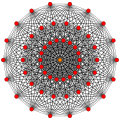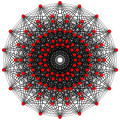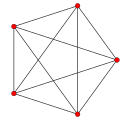Construction
It is created by a Wythoff construction upon a set of 7 hyperplane mirrors in 7-dimensional space. These mirrors are represented by its Coxeter-Dynkin diagram, 









 , and the ring represents the position of the active mirror(s).
, and the ring represents the position of the active mirror(s).
Removing the node on the end of the 3-length branch leaves the rectified 122 polytope, 








Removing the node on the end of the 2-length branch leaves the demihexeract, 131, 








Removing the node on the end of the 1-length branch leaves the birectified 6-simplex, 










The vertex figure is determined by removing the ringed node and ringing the neighboring node. This makes the tetrahedron-triangle duoprism prism, {3,3}×{3}×{}, 










Seen in a configuration matrix, the element counts can be derived by mirror removal and ratios of Coxeter group orders. [4]
| E7 |            | k-face | fk | f0 | f1 | f2 | f3 | f4 | f5 | f6 | k-figures | Notes |
|---|
| A3A2A1 |            | ( ) | f0 | 10080 | 24 | 24 | 12 | 36 | 8 | 12 | 36 | 18 | 24 | 4 | 12 | 18 | 24 | 12 | 6 | 6 | 8 | 12 | 6 | 3 | 4 | 2 | 3 | {3,3}x{3}x{ } | E7/A3A2A1 = 72*8!/4!/3!/2 = 10080 |
|---|
| A2A1A1 |            | { } | f1 | 2 | 120960 | 2 | 1 | 3 | 1 | 2 | 6 | 3 | 3 | 1 | 3 | 6 | 6 | 3 | 1 | 3 | 3 | 6 | 2 | 1 | 3 | 1 | 2 | ( )v{3}v{ } | E7/A2A1A1 = 72*8!/3!/2/2 = 120960 |
|---|
| A2A2 |            | 01 | f2 | 3 | 3 | 80640 | * | * | 1 | 1 | 3 | 0 | 0 | 1 | 3 | 3 | 3 | 0 | 0 | 3 | 3 | 3 | 1 | 0 | 3 | 1 | 1 | {3}v( )v( ) | E7/A2A2 = 72*8!/3!/3! = 80640 |
|---|
| A2A2A1 |            | 3 | 3 | * | 40320 | * | 0 | 2 | 0 | 3 | 0 | 1 | 0 | 6 | 0 | 3 | 0 | 3 | 0 | 6 | 0 | 1 | 3 | 0 | 2 | {3}v{ } | E7/A2A2A1 = 72*8!/3!/3!/2 = 40320 |
| A2A1A1 |            | 3 | 3 | * | * | 120960 | 0 | 0 | 2 | 1 | 2 | 0 | 1 | 2 | 4 | 2 | 1 | 1 | 2 | 4 | 2 | 1 | 2 | 1 | 2 | { }v{ }v( ) | E7/A2A1A1 = 72*8!/3!/2/2 = 120960 |
| A3A2 |            | 02 | f3 | 4 | 6 | 4 | 0 | 0 | 20160 | * | * | * | * | 1 | 3 | 0 | 0 | 0 | 0 | 3 | 3 | 0 | 0 | 0 | 3 | 1 | 0 | {3}v( ) | E7/A3A2 = 72*8!/4!/3! = 20160 |
|---|
           | 011 | 6 | 12 | 4 | 4 | 0 | * | 20160 | * | * | * | 1 | 0 | 3 | 0 | 0 | 0 | 3 | 0 | 3 | 0 | 0 | 3 | 0 | 1 |
| A3A1 |            | 6 | 12 | 4 | 0 | 4 | * | * | 60480 | * | * | 0 | 1 | 1 | 2 | 0 | 0 | 1 | 2 | 2 | 1 | 0 | 2 | 1 | 1 | Sphenoid | E7/A3A1 = 72*8!/4!/2 = 60480 |
| A3A1A1 |            | 6 | 12 | 0 | 4 | 4 | * | * | * | 30240 | * | 0 | 0 | 2 | 0 | 2 | 0 | 1 | 0 | 4 | 0 | 1 | 2 | 0 | 2 | { }v{ } | E7/A3A1A1 = 72*8!/4!/2/2 = 30240 |
| A3A1 |            | 02 | 4 | 6 | 0 | 0 | 4 | * | * | * | * | 60480 | 0 | 0 | 0 | 2 | 1 | 1 | 0 | 1 | 2 | 2 | 1 | 1 | 1 | 2 | Sphenoid | E7/A3A1 = 72*8!/4!/2 = 60480 |
| A4A2 |            | 021 | f4 | 10 | 30 | 20 | 10 | 0 | 5 | 5 | 0 | 0 | 0 | 4032 | * | * | * | * | * | 3 | 0 | 0 | 0 | 0 | 3 | 0 | 0 | {3} | E7/A4A2 = 72*8!/5!/3! = 4032 |
|---|
| A4A1 |            | 10 | 30 | 20 | 0 | 10 | 5 | 0 | 5 | 0 | 0 | * | 12096 | * | * | * | * | 1 | 2 | 0 | 0 | 0 | 2 | 1 | 0 | { }v() | E7/A4A1 = 72*8!/5!/2 = 12096 |
| D4A1 |            | 0111 | 24 | 96 | 32 | 32 | 32 | 0 | 8 | 8 | 8 | 0 | * | * | 7560 | * | * | * | 1 | 0 | 2 | 0 | 0 | 2 | 0 | 1 | E7/D4A1 = 72*8!/8/4!/2 = 7560 |
| A4 |            | 021 | 10 | 30 | 10 | 0 | 20 | 0 | 0 | 5 | 0 | 5 | * | * | * | 24192 | * | * | 0 | 1 | 1 | 1 | 0 | 1 | 1 | 1 | ( )v( )v( ) | E7/A4 = 72*8!/5! = 34192 |
| A4A1 |            | 10 | 30 | 0 | 10 | 20 | 0 | 0 | 0 | 5 | 5 | * | * | * | * | 12096 | * | 0 | 0 | 2 | 0 | 1 | 1 | 0 | 2 | { }v() | E7/A4A1 = 72*8!/5!/2 = 12096 |
           | 03 | 5 | 10 | 0 | 0 | 10 | 0 | 0 | 0 | 0 | 5 | * | * | * | * | * | 12096 | 0 | 0 | 0 | 2 | 1 | 0 | 1 | 2 |
| D5A1 |            | 0211 | f5 | 80 | 480 | 320 | 160 | 160 | 80 | 80 | 80 | 40 | 0 | 16 | 16 | 10 | 0 | 0 | 0 | 756 | * | * | * | * | 2 | 0 | 0 | { } | E7/D5A1 = 72*8!/16/5!/2 = 756 |
|---|
| A5 |            | 022 | 20 | 90 | 60 | 0 | 60 | 15 | 0 | 30 | 0 | 15 | 0 | 6 | 0 | 6 | 0 | 0 | * | 4032 | * | * | * | 1 | 1 | 0 | E7/A5 = 72*8!/6! = 4032 |
| D5 |            | 0211 | 80 | 480 | 160 | 160 | 320 | 0 | 40 | 80 | 80 | 80 | 0 | 0 | 10 | 16 | 16 | 0 | * | * | 1512 | * | * | 1 | 0 | 1 | E7/D5 = 72*8!/16/5! = 1512 |
| A5 |            | 031 | 15 | 60 | 20 | 0 | 60 | 0 | 0 | 15 | 0 | 30 | 0 | 0 | 0 | 6 | 0 | 6 | * | * | * | 4032 | * | 0 | 1 | 1 | E7/A5 = 72*8!/6! = 4032 |
| A5A1 |            | 15 | 60 | 0 | 20 | 60 | 0 | 0 | 0 | 15 | 30 | 0 | 0 | 0 | 0 | 6 | 6 | * | * | * | * | 2016 | 0 | 0 | 2 | E7/A5A1 = 72*8!/6!/2 = 2016 |
| E6 |            | 0221 | f6 | 720 | 6480 | 4320 | 2160 | 4320 | 1080 | 1080 | 2160 | 1080 | 1080 | 216 | 432 | 270 | 432 | 216 | 0 | 27 | 72 | 27 | 0 | 0 | 56 | * | * | ( ) | E7/E6 = 72*8!/72/6! = 56 |
|---|
| A6 |            | 032 | 35 | 210 | 140 | 0 | 210 | 35 | 0 | 105 | 0 | 105 | 0 | 21 | 0 | 42 | 0 | 21 | 0 | 7 | 0 | 7 | 0 | * | 576 | * | E7/A6 = 72*8!/7! = 576 |
| D6 |            | 0311 | 240 | 1920 | 640 | 640 | 1920 | 0 | 160 | 480 | 480 | 960 | 0 | 0 | 60 | 192 | 192 | 192 | 0 | 0 | 12 | 32 | 32 | * | * | 126 | E7/D6 = 72*8!/32/6! = 126 |







![]()
![]()
![]()
![]()
![]()
![]()
![]()
![]()
![]()
![]()
![]() .
.

























